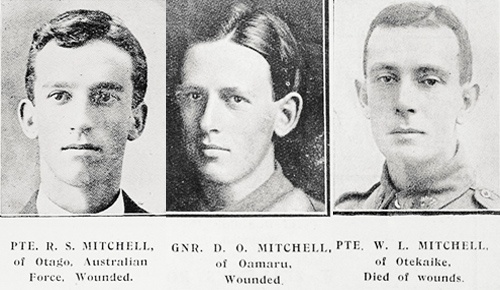
The Mitchell family of North Otago exemplified the imperial unity and devotion that was characteristic of many New Zealand families during the First World War. All three sons fought for Britain during the war, one with the New Zealand Expeditionary Force (NZEF) and two with the Australian Imperial Force (AIF).
During the war, Australia and New Zealand’s Expeditionary Forces often fought side by side and for a time formed the Australian and New Zealand Army Corps. New Zealand’s wartime Minister of Defence, Sir James Allen, was Australian-born, and over 2000 New Zealanders are thought to have served with the AIF.
All three Mitchell brothers grew up in Ōamaru and Ōtekaieke in North Otago. By 1911, the eldest two, Robert and William, had moved to Western Australia, running a farm near Pintharuka, inland from Geraldton. When war broke out in August 1914, Robert enlisted in the AIF and was among the first to land at Anzac Cove, Gallipoli, on 25 April 1915. A week later, a serious gunshot wound led to the amputation of his left arm and the end of his war. Invalided back to Australia, Robert received a formal discharge from the AIF in February 1916. By this time, his youngest brother, Douglas, had enlisted in the NZEF. Sent to the Western Front, he died of wounds on 17 August 1917. Back in Australia, William looked after Robert’s farm while he recovered, but in May 1916, he too enlisted in the AIF. William served on the Western Front for eight months. He died at a casualty clearing station on 6 October 1917, two days after receiving a gunshot wound to his spine during an assault at Zonnebeke in Belgium. William was buried in Lijssenthoek Military Cemetery.
The death of two sons and the serious wounding of another had an enormous effect on the Mitchell family, who, along with the local community, sought to preserve the deceased men’s memories through objects and memorials. The Mitchell family treasured William’s memorial plaque, Victory Medal and a photo of his gravesite received from the Australian authorities. In a poignant letter to the Australian Base Records Office on 4 September 1921 William’s mother, Florence, wrote:
Dear Sir
We have received medals for our son 5894, Pri. W.L. Mitchell, 27th Battalion, I am now writing to ask have you the Memorial Scroll signed by the King for distribution. N.Z. has been issuing the same and we have received a copy for our youngest boy who left from here + died in France.
Hoping to hear from you.
Yours truly,
Florence Mitchell
As both William and Douglas had grown up near Ōtekaieke, their names were included on the town’s war memorial gates, even though William had fought in the AIF. Locals also planted 400 oak trees in Ōamaru as a memorial to each soldier from the North Otago district killed during the war. Each tree carried a brass plaque, inscribed with the names of the dead. While many of the trees flourished, disease, roadworks and vehicle crashes took a toll of others. William and Douglas’ oaks may have succumbed to such a fate, as the plaques are now installed on the gates of Mount Dasher Station, the site of a property that the New Zealand government awarded their brother Robert as a returned (albeit AIF) soldier. Across the ditch, Robert and William’s names appear on the Mingenew War Memorial at Mingenew, near Pintharuka.
Further information
- Australian War Memorial record (Robert Mitchell)
- Auckland Museum Cenotaph record (Douglas Mitchell)
- Australian War Memorial record (William Mitchell)
- Casualty details (CWGC) - Douglas Mitchell, William Mitchell
- North Otago memorial oaks (NZHistory)
- Ōtekaieke war memorial (NZHistory)
- Mt Dasher Station memorial (NZHistory)

Community contributions